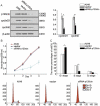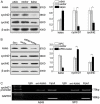P120-catenin isoforms 1 and 3 regulate proliferation and cell cycle of lung cancer cells via β-catenin and Kaiso respectively
- PMID: 22276175
- PMCID: PMC3262806
- DOI: 10.1371/journal.pone.0030303
P120-catenin isoforms 1 and 3 regulate proliferation and cell cycle of lung cancer cells via β-catenin and Kaiso respectively
Abstract
Background: The different mechanisms involved in p120-catenin (p120ctn) isoforms' 1/3 regulation of cell cycle progression are still not elucidated to date.
Methods and findings: We found that both cyclin D1 and cyclin E could be effectively restored by restitution of p120ctn-1A or p120ctn-3A in p120ctn depleted lung cancer cells. When the expression of cyclin D1 was blocked by co-transfection with siRNA-cyclin D1 in p120ctn depleted cells restoring p120ctn-1A or 3A, the expression of cyclin E was slightly decreased, not increased, implying that p120ctn isoforms 1 and 3 cannot up-regulate cyclin E directly but may do so through up-regulation of cyclin D1. Interestingly, overexpression of p120ctn-1A increased β-catenin and cyclin D1 expression, while co-transfection with siRNA targeting β-catenin abolishes the effect of p120ctn-1A on up-regulation of cyclin D1, suggesting a role of β-catenin in mediating p120ctn-1A's regulatory function on cyclin D1 expression. On the other hand, overexpression of p120ctn isoform 3A reduced nuclear Kaiso localization, thus decreasing the binding of Kaiso to KBS on the cyclin D1 promoter and thereby enhancing the expression of cyclin D1 gene by relieving the repressor effect of Kaiso. Because overexpressing NLS-p120ctn-3A (p120ctn-3A nuclear target localization plasmids) or inhibiting nuclear export of p120ctn-3 by Leptomycin B (LMB) caused translocation of Kaiso to the nucleus, it is plausible that the nuclear export of Kaiso is p120ctn-3-dependent.
Conclusions: Our results suggest that p120ctn isoforms 1 and 3 up-regulate cyclin D1, and thereby cyclin E, resulting in the promotion of cell proliferation and cell cycle progression in lung cancer cells probably via different protein mediators, namely, β-catenin for isoform 1 and Kaiso, a negative transcriptional factor of cyclin D1, for isoform 3.
Conflict of interest statement
Figures









Similar articles
-
Kaiso interacts with p120-catenin to regulate β-catenin expression at the transcriptional level.PLoS One. 2014 Feb 3;9(2):e87537. doi: 10.1371/journal.pone.0087537. eCollection 2014. PLoS One. 2014. PMID: 24498333 Free PMC article.
-
Kaiso is expressed in lung cancer: its expression and localization is affected by p120ctn.Lung Cancer. 2010 Feb;67(2):205-15. doi: 10.1016/j.lungcan.2009.06.013. Epub 2009 Jul 16. Lung Cancer. 2010. Retraction in: Lung Cancer. 2016 Dec;102:141. doi: 10.1016/j.lungcan.2016.11.015. PMID: 19615783 Retracted.
-
P120ctn overexpression enhances beta-catenin-E-cadherin binding and down regulates expression of survivin and cyclin D1 in BEL-7404 hepatoma cells.World J Gastroenterol. 2006 Feb 28;12(8):1187-91. doi: 10.3748/wjg.v12.i8.1187. World J Gastroenterol. 2006. PMID: 16534869 Free PMC article.
-
A role for Kaiso-p120ctn complexes in cancer?Nat Rev Cancer. 2005 Dec;5(12):956-64. doi: 10.1038/nrc1752. Nat Rev Cancer. 2005. PMID: 16294216 Review.
-
Dancing in and out of the nucleus: p120(ctn) and the transcription factor Kaiso.Biochim Biophys Acta. 2007 Jan;1773(1):59-68. doi: 10.1016/j.bbamcr.2006.08.052. Epub 2006 Sep 7. Biochim Biophys Acta. 2007. PMID: 17050009 Review.
Cited by
-
Adherens junction proteins on the move-From the membrane to the nucleus in intestinal diseases.Front Cell Dev Biol. 2022 Oct 5;10:998373. doi: 10.3389/fcell.2022.998373. eCollection 2022. Front Cell Dev Biol. 2022. PMID: 36274850 Free PMC article. Review.
-
Kaiso interacts with p120-catenin to regulate β-catenin expression at the transcriptional level.PLoS One. 2014 Feb 3;9(2):e87537. doi: 10.1371/journal.pone.0087537. eCollection 2014. PLoS One. 2014. PMID: 24498333 Free PMC article.
-
Beyond β-catenin: prospects for a larger catenin network in the nucleus.Nat Rev Mol Cell Biol. 2016 Jan;17(1):55-64. doi: 10.1038/nrm.2015.3. Epub 2015 Nov 18. Nat Rev Mol Cell Biol. 2016. PMID: 26580716 Free PMC article. Review.
-
Kaiso differentially regulates components of the Notch signaling pathway in intestinal cells.Cell Commun Signal. 2017 Jun 21;15(1):24. doi: 10.1186/s12964-017-0178-x. Cell Commun Signal. 2017. PMID: 28637464 Free PMC article.
-
Delta-catenin is required for cell proliferation in virus-positive Merkel cell carcinoma cell lines but not in human fibroblasts.mBio. 2025 Jun 11;16(6):e0083225. doi: 10.1128/mbio.00832-25. Epub 2025 May 23. mBio. 2025. PMID: 40407323 Free PMC article.
References
-
- Liu Y, Dong QZ, Zhao Y, Dong XJ, Miao Y, et al. P120-catenin isoforms 1A and 3A differently affect invasion and proliferation of lung cancer cells. Exp Cell Res. 2009;315(5):890–898. - PubMed
-
- Dai SD, Wang Y, Jiang GY, Zhang PX, Dong XJ, et al. Kaiso is expressed in lung cancer: its expression and localization is affected by p120ctn. Lung Cancer. 2010;67(2):205–15. - PubMed
Publication types
MeSH terms
Substances
LinkOut - more resources
Full Text Sources
Medical
Research Materials
Miscellaneous

